The Business Model Canvas: A Strategic Management Tool
Table of Contents
Open Table of Contents
The Nine Building Blocks
The Business Model Canvas is an innovative visual tool that showcases nine essential building blocks, illustrating how your organisation creates, delivers, and captures value. These building blocks fall into four key areas: customers, offerings, infrastructure, and financial viability. By exploring and understanding these components, you can empower yourself to design, implement, and manage a robust business model that drives lasting success.
Imagine the possibilities of mastering these nine building blocks! Whether you’re starting a new venture or looking to revitalise an existing one, this framework can be your roadmap to transforming your ideas into a thriving enterprise.
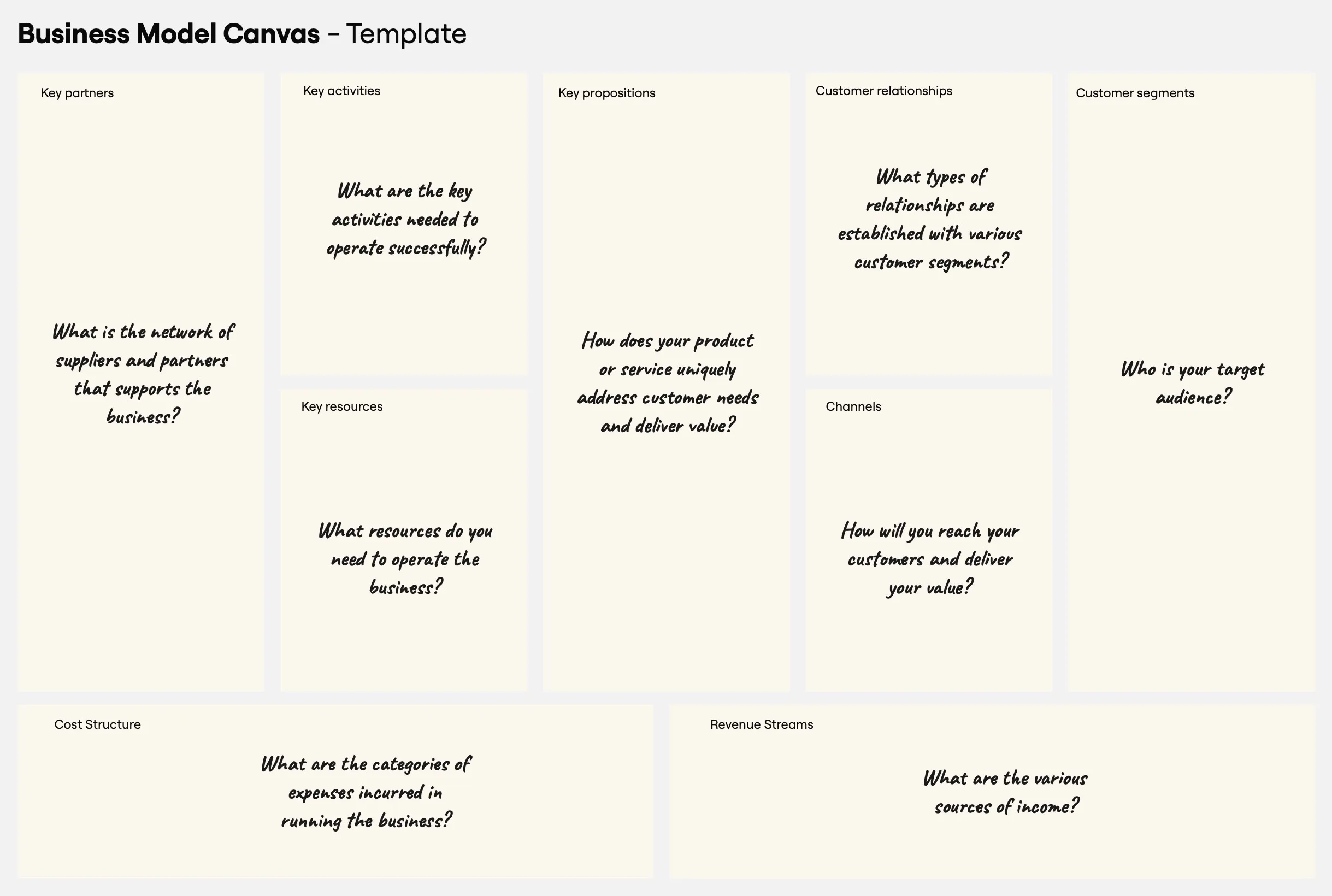
- Customer Segments: This block identifies the various groups of people or organisations your business seeks to reach and serve. Understanding your customers’ needs, behaviours, and attributes is essential, as they are at the heart of any successful business model.
- Value Propositions: Here, you outline the bundle of products and services that deliver value to your specific Customer Segments. This is why customers choose one company over another. A compelling value proposition addresses a customer problem or meets a customer need.
- Channels: This block details how your company communicates with and reaches its Customer Segments to deliver the Value Proposition. This includes various channels for communication, distribution, and sales.
- Customer Relationships: This section describes the type of relationships your company maintains with each Customer Segment. Relationships can range from personal to automated, significantly influencing customer experience.
- Revenue Streams: This block illustrates the cash generated from each Customer Segment. Revenue streams may include asset sales, usage fees, subscription fees, lending, renting, leasing, licensing, brokerage fees, or advertising.
- Key Resources: Here, you identify the most critical assets essential for your business model’s functionality. These resources can be physical, financial, intellectual, or human, and are vital for creating and offering a Value Proposition, reaching markets, maintaining Customer Relationships, and generating revenue.
- Key Activities: This block outlines the crucial actions your company must perform to make the business model work successfully. These strategic activities are essential for operational success.
- Key Partnerships: This section describes the network of suppliers and partners that supports your business model. Partnerships can be formed for several reasons, such as optimizing operations, mitigating risks, or acquiring necessary resources.
- Cost Structure: Finally, this block outlines all costs associated with operating your business model, including expenses related to creating and delivering value, maintaining Customer Relationships, and generating revenue.
Case example: PayGo
To illustrate the application of the Business Model Canvas, we will use a case study of a digital payment platform throughout this comprehensive guide. The digital payment platform, which we will call “PayGo,” is a fictional company that provides online payment solutions to individuals and businesses. Its mission is to make payments fast, secure, and convenient for its users.
This guide will use PayGo as a real-world example to explore the Business Model Canvas framework. We will analyse PayGo’s business model, identifying its key elements, such as customer segments, value propositions, channels, and revenue streams. We will also examine how PayGo uses the Business Model Canvas to innovate, improve its business model, and address market challenges and opportunities.
Using PayGo as a case study, we will demonstrate how the Business Model Canvas can be applied to design, innovate, and iterate a business model. We will also provide insights and lessons learned from PayGo’s experience, highlighting the benefits and challenges of using the Business Model Canvas in a real-world setting.
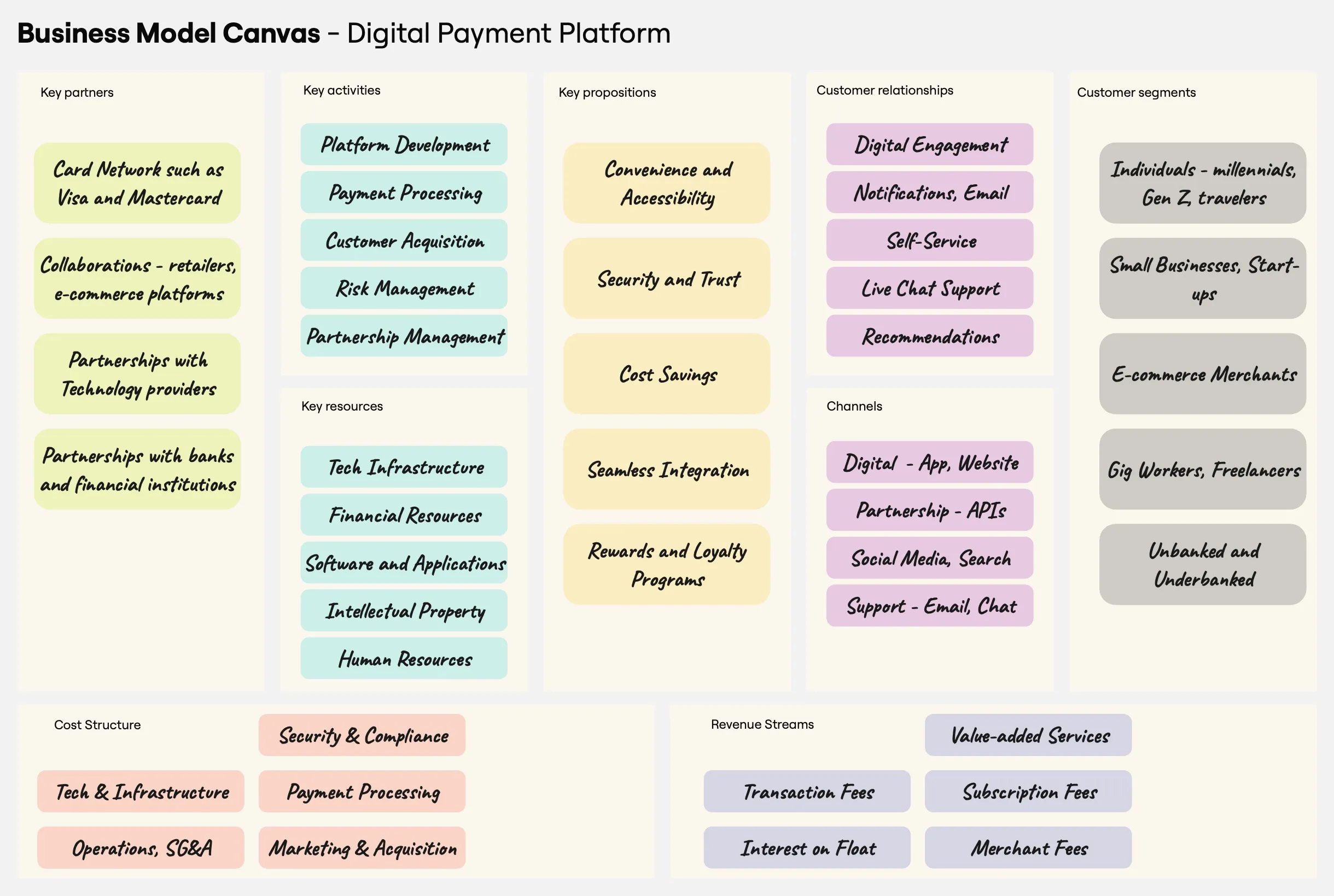
Let’s analyze PayGo’s business model using the Business Model Canvas:
- Customer Segments : PayGo’s customer segments include individuals, small businesses, and merchants who require fast, secure, and convenient payment solutions.
- Value Propositions : PayGo’s value proposition includes its user-friendly mobile app, fast transaction processing, and robust security measures to protect users’ financial information.
- Channels : PayGo uses various channels to reach its customers, including its mobile app, website, social media, and partnerships with merchants and financial institutions.
- Customer Relationships : PayGo establishes strong relationships with its customers through its customer support team, which provides assistance and resolves issues promptly.
- Revenue Streams : PayGo’s revenue streams include transaction fees, interest on funds held in user accounts, and partnerships with merchants and financial institutions.
- Key Resources : PayGo’s key resources include its technological infrastructure, skilled personnel, and financial resources.
- Key Activities : PayGo’s key activities include developing and maintaining its mobile app, processing transactions, and providing customer support.
- Key Partnerships : PayGo partners with financial institutions, merchants, and technology providers to offer its services and expand its reach.
- Cost Structure : PayGo’s cost structure includes technology and infrastructure costs, payment processing fees, customer support and operations costs, marketing and acquisition costs, regulatory compliance and security costs, and personnel and training costs.
Now that we have introduced PayGo as our case study, let’s dive deeper into its business model by exploring each of the nine building blocks of the Business Model Canvas, starting with Customer Segments.
1. Customer Segments
In the Business Model Canvas, Customer Segments represent the various groups of people or organizations that your enterprise aims to reach and serve. Understanding these segments is essential, as each group has distinct needs, behaviors, and attributes that can greatly influence the design of your business model.
By identifying and analyzing your customer segments, you can tailor your offerings to meet their specific requirements, ensuring you create meaningful value for them. This understanding not only helps in developing targeted marketing strategies but also enhances customer satisfaction and loyalty.
Recognizing the diverse characteristics of your customer segments empowers you to adapt your approach and ultimately drive the success of your business.
For PayGo, its customer segments include:
- Individuals : This segment encompasses a wide range of consumers who use PayGo’s services for personal transactions, such as sending money to friends and family, paying bills, or making online purchases.
- Small Businesses : Small businesses often require efficient and cost-effective payment solutions to receive customer payments, pay suppliers, and manage cash flow.
- Merchants : Online retailers and e-commerce platforms rely on digital payment systems like PayGo to facilitate secure and convenient customer transactions.
- Gig Workers and Freelancers : As the gig economy rises, freelancers and independent contractors need easy ways to receive payments for their services.
- Unbanked and Underbanked Populations : A significant portion of the global population lacks access to traditional banking services, creating a demand for alternative digital payment solutions like PayGo.
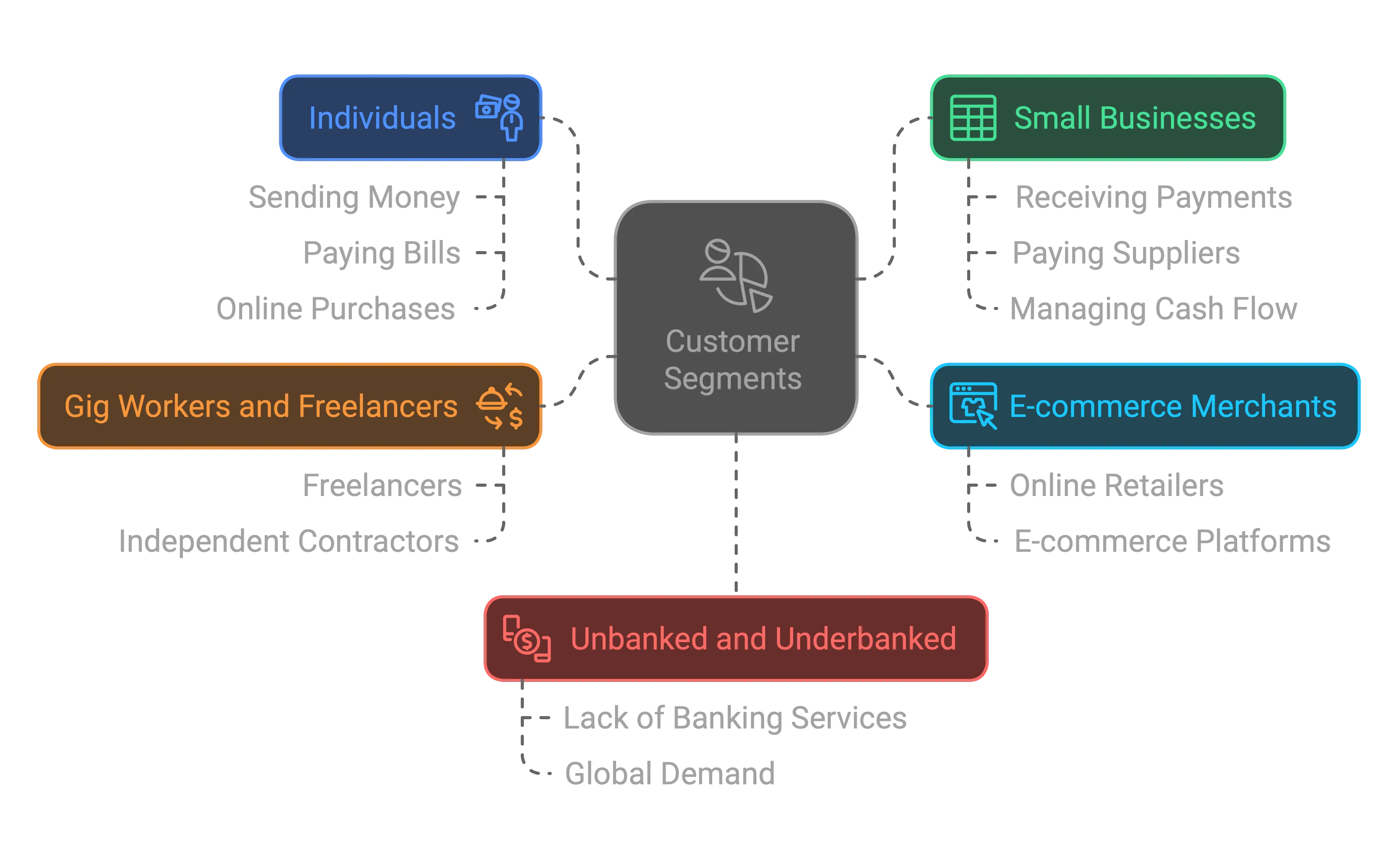
To effectively serve these customer segments, PayGo must understand their unique needs, preferences, and pain points. For example, individuals may prioritise ease of use and low transaction fees, while small businesses may value robust reporting and accounting integration. By identifying and understanding the target customer segments, PayGo can tailor its value propositions, channels, and relationships to meet their specific needs.
The next crucial element in the Business Model Canvas is the Value Proposition, which builds directly upon your understanding of customer segments.
2. Value Propositions
A value proposition is the compelling reason customers choose one company’s product or service over another. It’s the unique blend of benefits and features that a business offers to its target customers, addressing their specific needs and desires.
Crafting a strong value proposition involves highlighting what sets your offerings apart from the competition. This could include exceptional quality, convenience, pricing, or innovative features. A well-defined value proposition not only attracts customers but also reinforces their decision to engage with your brand.
By clearly articulating the value you provide, you can effectively communicate why your customers should select your solution and foster deeper connections that drive loyalty and satisfaction.
For PayGo, the value propositions could include:
- Convenience and Accessibility : PayGo allows customers to transact anytime, anywhere, using their mobile devices or computers.
- Security and Trust : PayGo ensures the security of customers’ financial information and transactions through robust encryption and fraud detection mechanisms.
- Cost Savings : PayGo often has lower transaction fees than traditional payment methods, saving money for customers and merchants.
- Seamless Integration : For businesses, PayGo can integrate seamlessly with their existing systems, such as accounting software or e-commerce platforms, streamlining operations and improving efficiency.
- Financial Management Tools : PayGo may offer additional features, such as budgeting tools, spending analysis, and investment options, to provide customers with a comprehensive financial management solution.
- Rewards and Loyalty Programs : PayGo may offer rewards, cashback, or loyalty programs for frequent users to incentivise usage and retain customers.
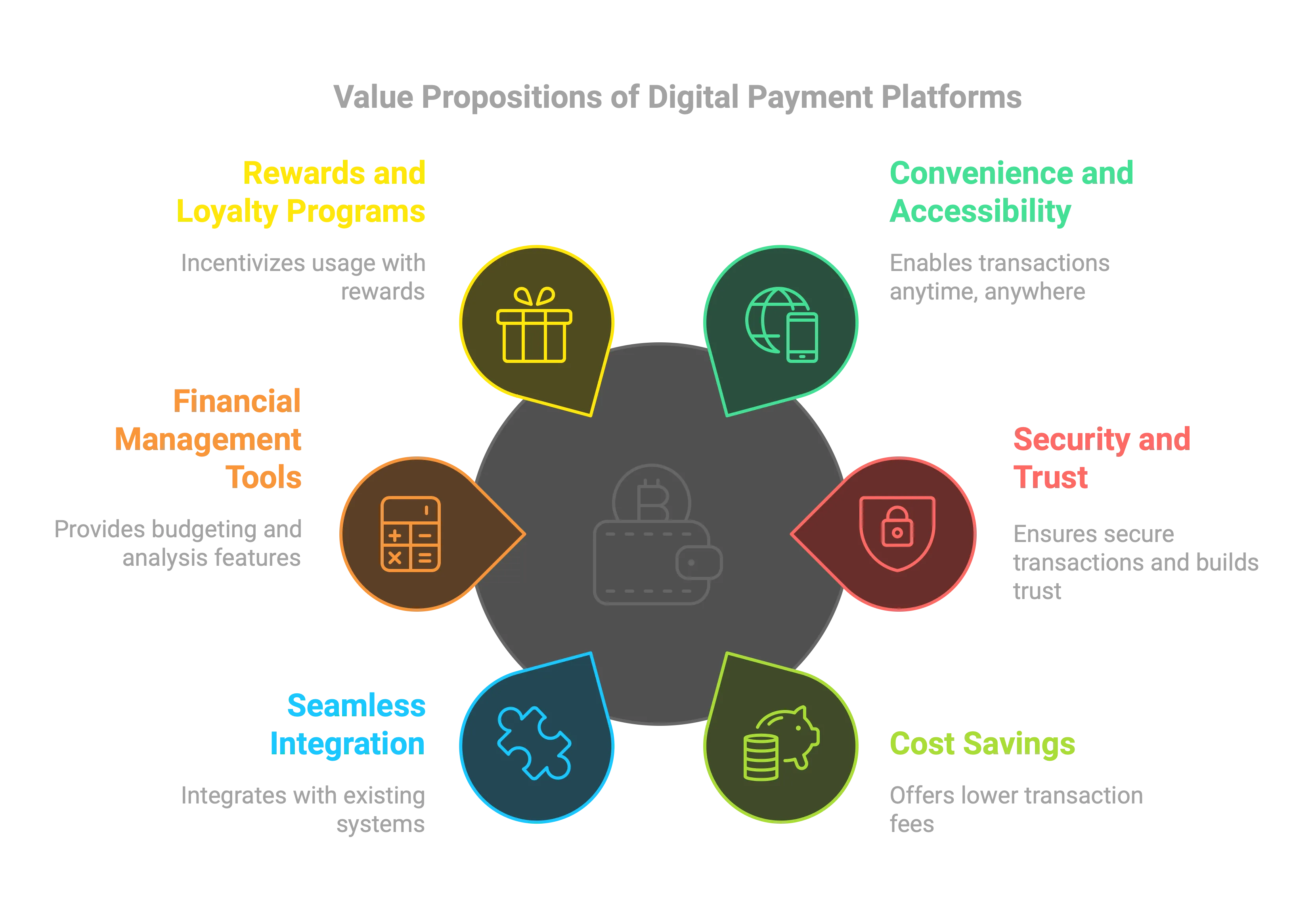
It’s essential to note that customer segments may value different aspects of PayGo’s services. For example, individual consumers may prioritise convenience and security, while businesses may emphasise cost savings and seamless integration.
With value defined, it’s time to explore the diverse Channels through which we can connect and deliver those compelling offers directly to our customers.
3. Channels
Channels represent the various ways a company communicates and delivers its value proposition to its customer segments. These channels are essential as they ensure that the value you offer reaches your customers effectively and efficiently. Ultimately, the synergy between your value propositions and your chosen channels enhances the overall customer experience, driving engagement and satisfaction.
In the context of PayGo, these channels are crucial in ensuring a seamless and convenient experience for users.
Effective channels encompass various methods of communication and delivery, such as online platforms, mobile apps, customer service teams, and marketing initiatives. By leveraging the right channels, PayGo can reach its target audience more effectively, ensuring that the value proposition resonates and reaches customers where they are most active.
The primary channel for PayGo is typically its mobile application or website. These digital channels allow users to easily access PayGo’s services, create accounts, link payment methods, and initiate transactions. The user interface and user experience design of these channels should be intuitive, user-friendly, and optimised for various devices and screen sizes.
In addition to the primary digital channels, PayGo may leverage other channels to reach and serve customers:
- Partnership channels : Collaborating with banks, financial institutions, or e-commerce platforms can provide access to a broader customer base and enable PayGo’s integration into existing services or applications.
- Social media channels : Maintaining an active presence on social media platforms can help build brand awareness, engage with customers, and provide customer support or updates on new features.
- Customer support channels : Offering multiple customer support channels, such as email, phone, live chat, or chatbots, can enhance the customer experience and address any issues or inquiries promptly.
- Marketing and advertising channels : Utilising various marketing channels, such as search engine marketing, email marketing, influencer marketing, or targeted advertising, can help acquire new customers and promote PayGo’s services.
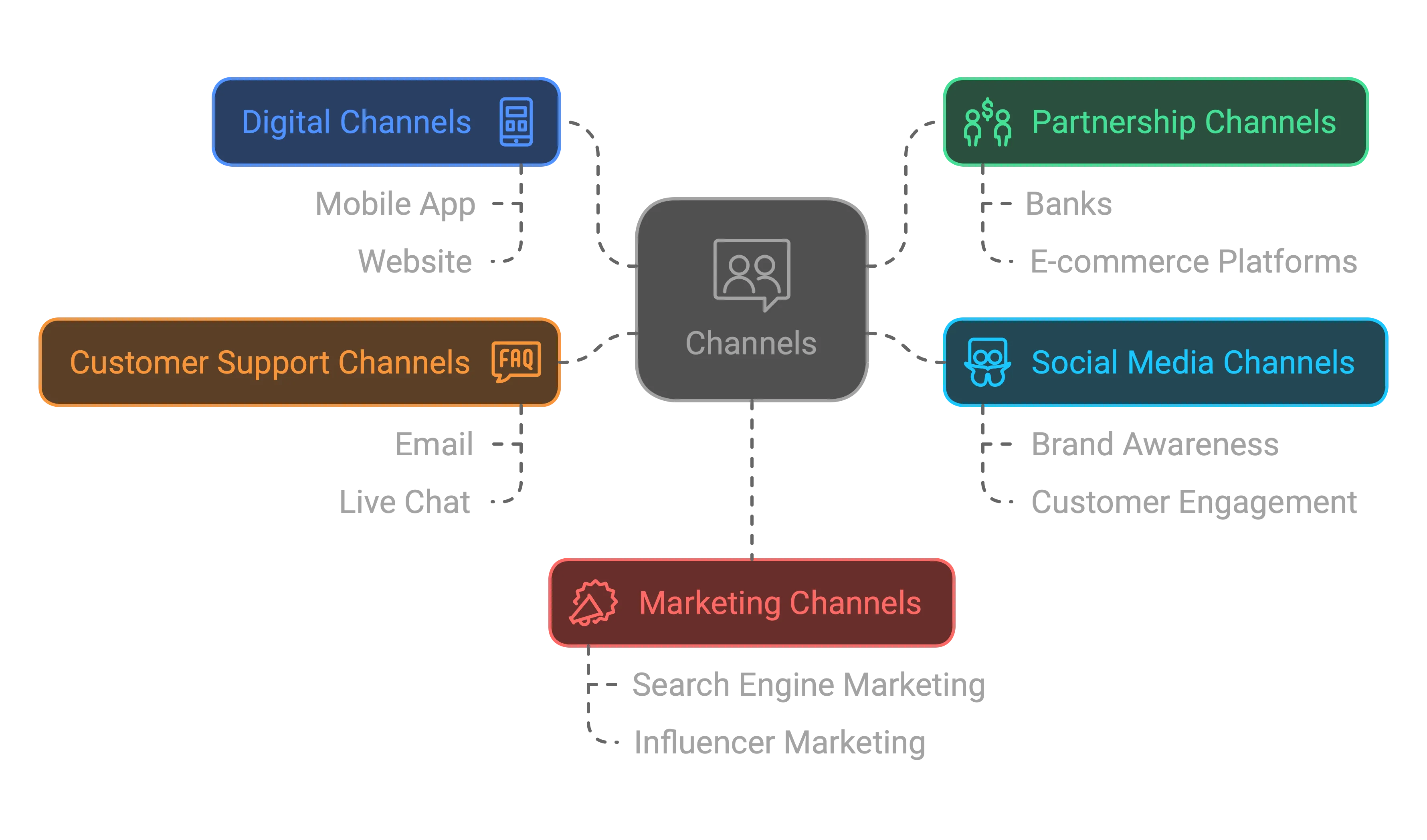
When choosing channels, factors like customer preferences, convenience, cost-effectiveness, and the ability to provide a consistent and seamless experience across all touchpoints must be considered. Regularly evaluating and optimising channel strategies based on customer feedback and usage data can help ensure PayGo remains accessible and relevant to its target audience.
These channels pave the way for meaningful Customer Relationships, allowing us to foster loyalty and deepen our connections—essential for lasting success.
4. Customer Relationships
In today’s competitive landscape, building and nurturing strong customer relationships isn’t just beneficial—it’s essential for the long-term success of any business model. When you invest in creating meaningful connections with your customers, you not only enhance their satisfaction but also foster loyalty that can lead to lasting partnerships. Let’s explore how cultivating these relationships can elevate your business to new heights!
In this context, customer relationships refer to the interactions between PayGo and its customer segments. These relationships can range from highly personal and individualised to fully automated and self-service.
PayGo may employ a combination of different customer relationship strategies. For example, the company may offer self-service channels, such as its mobile app or website, allowing customers to access services and resolve issues independently and conveniently. This approach enhances customer convenience and reduces PayGo’s operational costs.
On the other hand, PayGo may establish dedicated personal assistance for specific customer segments, such as high-value clients or businesses. This could involve assigning account managers or customer success teams to provide personalised support, address complex inquiries, and ensure customer satisfaction. Regular communication channels, such as email, phone, or even in-person meetings, can be established to foster strong relationships and build trust.
Additionally, PayGo may leverage co-creation and crowdsourcing strategies to actively involve customers in developing and improving its services. This can be achieved through online forums, feedback mechanisms, or even beta testing programs, where customers can contribute their insights and ideas, fostering a sense of ownership and loyalty.
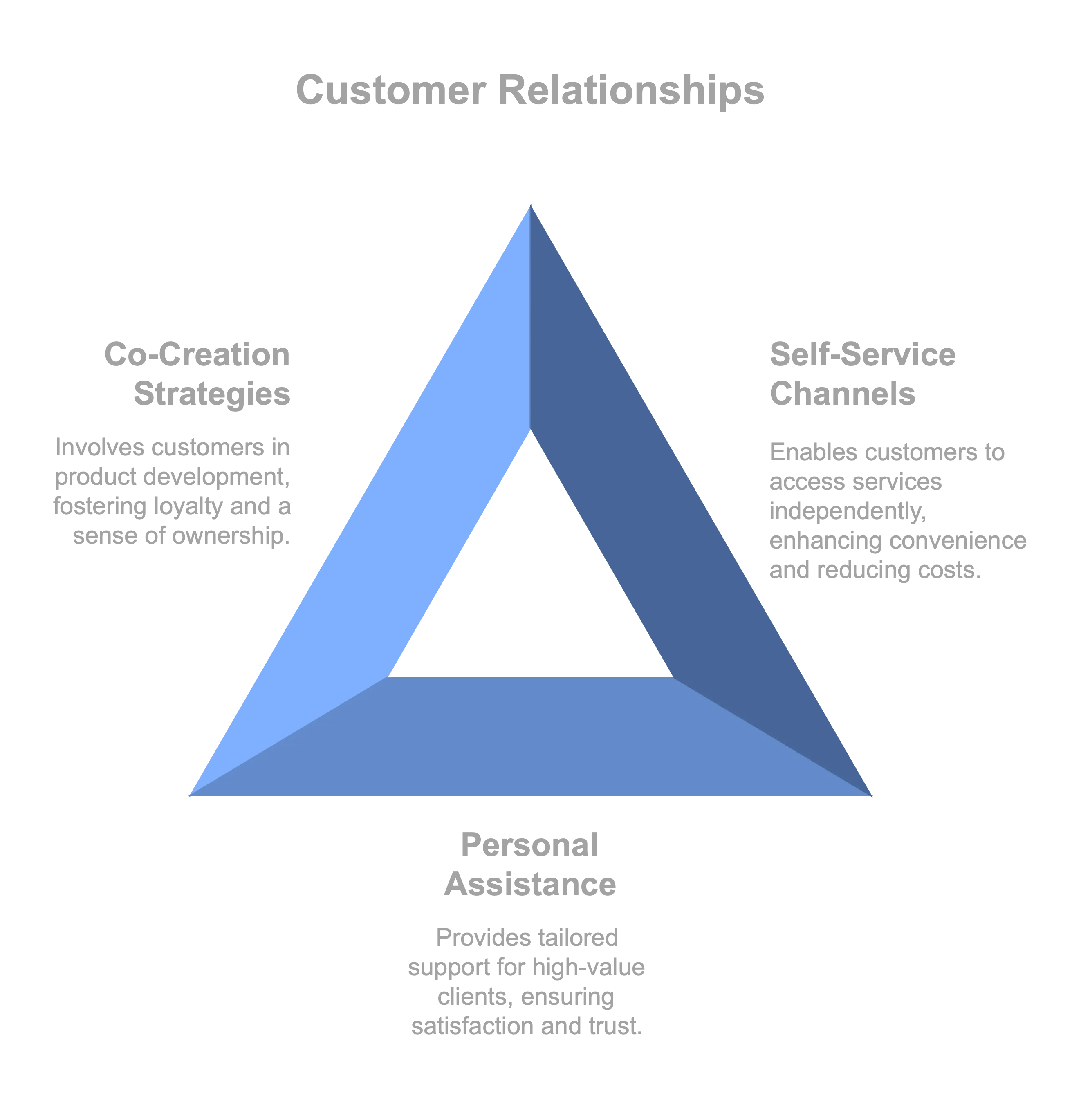
Regardless of the strategies employed, PayGo must prioritise customer relationships and strive to deliver exceptional customer experiences. This could include implementing robust customer support systems, offering multiple communication channels, and continuously gathering and acting upon customer feedback. By building and maintaining strong customer relationships, PayGo can increase customer satisfaction, loyalty, and long-term success in the competitive digital payment landscape.
This engagement naturally invites us to consider our Revenue Streams, revealing the exciting opportunities for generating income from our valuable relationships.
5. Revenue Streams
Revenue streams represent the lifeblood of any business, as they highlight the cash flows generated from each customer segment. Identifying and optimizing these revenue streams is not just important—it’s vital for ensuring the success and sustainability of your business model. By understanding how to diversify and enhance these streams, you can unlock new opportunities for growth and resilience in an ever-evolving market. Let’s dive into the strategies that can help PayGo maximize its revenue potential!
For PayGo, the primary revenue streams may include:
- Transaction Fees : A small percentage is charged for processing each transaction made through the platform. This is a standard revenue model for payment gateways and digital wallets.
- Subscription Fees : Monthly or annual fees charged to businesses or individuals for using PayGo’s advanced features, premium services, or higher transaction limits.
- Interest on Float : The interest earned on the funds held temporarily in PayGo’s accounts before they are transferred to the recipient’s account. This revenue stream is particularly relevant for platforms handling large transaction volumes.
- Merchant Fees : Fixed or variable fees are charged to merchants for accepting payments through PayGo. These fees may be based on transaction volume, value, or both.
- Value-added Services : Additional revenue can be generated by offering complementary services like fraud protection, invoicing, accounting integrations, or data analytics for an additional fee.
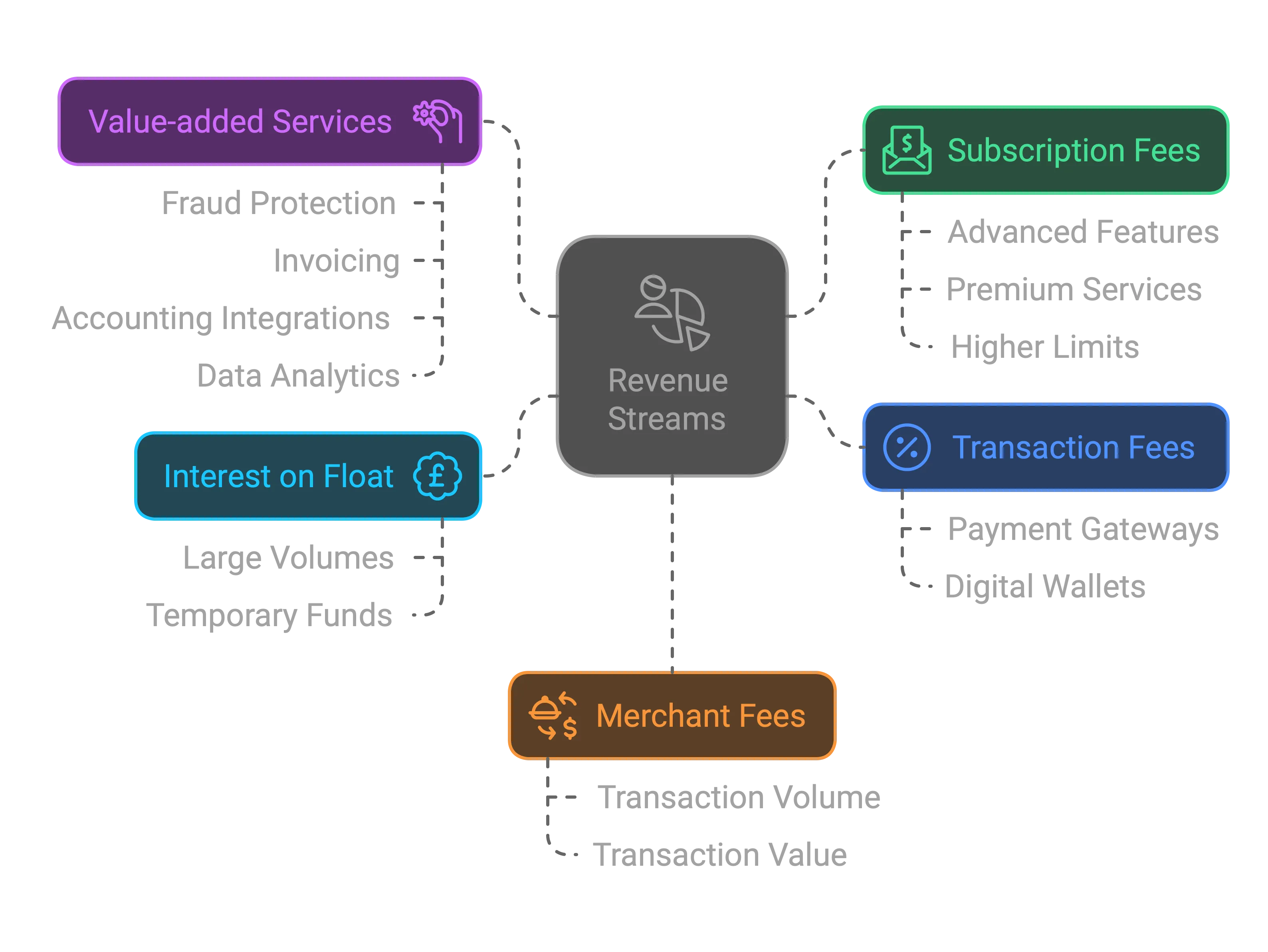
PayGo should continuously analyze customer behavior, market trends, and competitor offerings to optimize its revenue streams. This analysis can help identify opportunities for introducing new revenue streams, adjusting pricing models, or bundling services to increase customer lifetime value. Additionally, providing exceptional user experiences and building trust can lead to higher adoption rates, transaction volumes, and increased revenue.
To make this revenue a reality, we must identify our essential Key Resources, the vital assets that will empower us to deliver on our promises.
6. Key Resources
Key resources are the backbone of any successful business model; they are the critical assets that enable an enterprise to thrive. These resources empower your business to create and deliver a compelling value proposition, connect with target markets, build strong relationships with customer segments, and generate revenue.
Resources can take many forms—physical, financial, intellectual, or human—and can be owned, leased, or acquired through strategic partnerships. Understanding and leveraging these resources is essential for maximizing your business’s potential and driving long-term success.
Let’s explore how to identify and optimize these invaluable assets for PayGo!
- Technological Infrastructure : A robust and scalable technological infrastructure is essential for a seamless digital payment platform. This includes servers, data centers, networks, and other hardware components required to process transactions and securely handle large volumes of data.
- Software and Applications : The core offering of PayGo is its software and applications. These include the payment gateway, mobile apps, web interfaces, and other software solutions that enable users to make and receive payments conveniently.
- Intellectual Property : Intellectual property, such as patents, copyrights, and trade secrets, can be crucial for PayGo to maintain a competitive advantage. This includes proprietary algorithms, encryption techniques, and other innovative technologies developed by the company.
- Human Resources : PayGo requires a skilled workforce to develop, maintain, and support its products and services. This includes software engineers, cybersecurity experts, customer support personnel, and other professionals with relevant expertise.
- Financial Resources : Substantial financial resources are required to establish and operate a digital payment platform. These resources are needed for infrastructure investment, research and development, marketing, and other operational expenses.
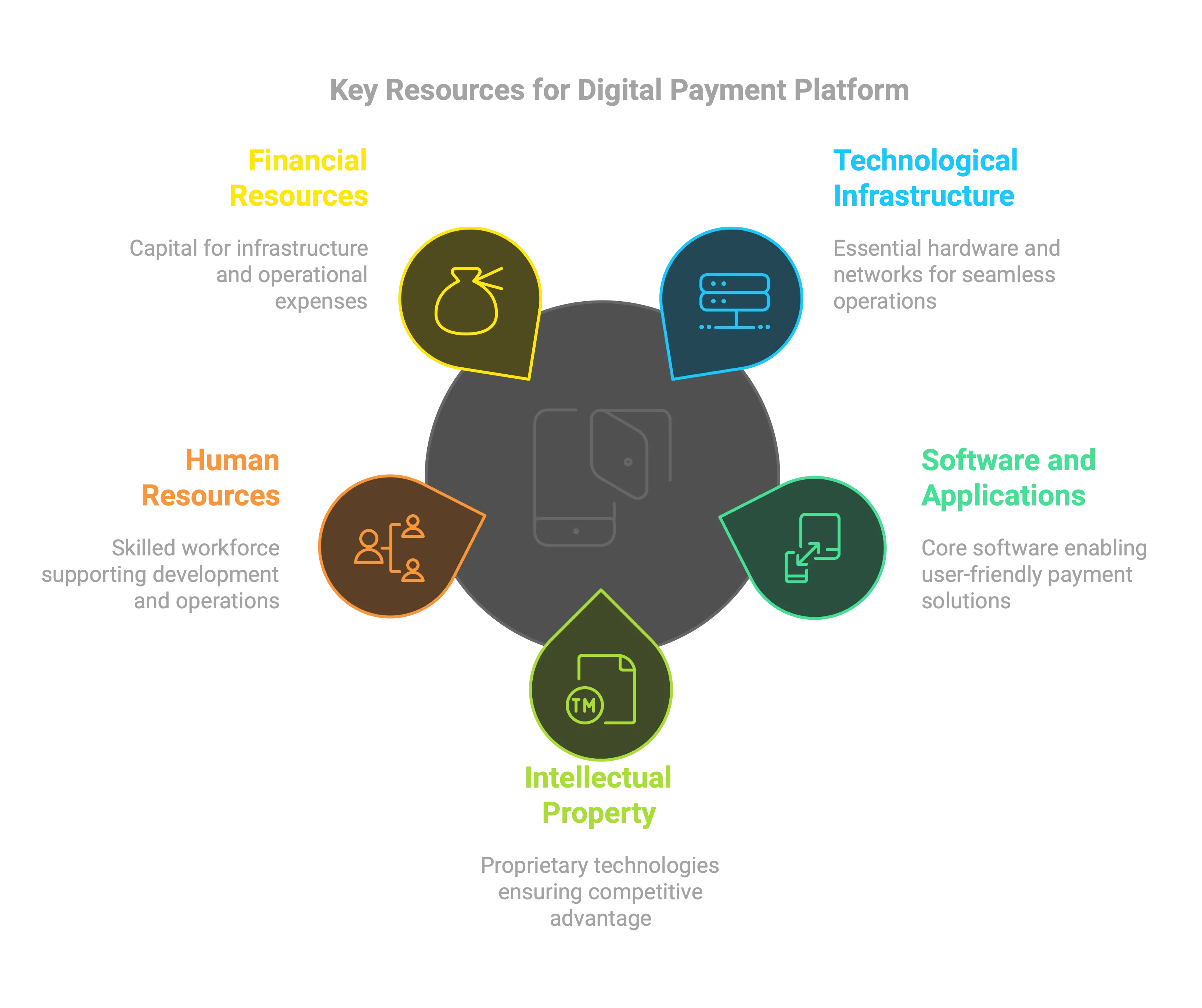
By carefully identifying and acquiring the necessary key resources, PayGo can effectively deliver its value proposition and maintain a sustainable business model.
Armed with our resources, our focus shifts to Key Activities, the dynamic actions we must take to drive effectiveness and innovation in our operations.
7. Key Activities
Key activities are the driving force behind a company’s success, representing the essential actions needed to bring your business model to life. These activities play a crucial role in crafting compelling value propositions, connecting with your target markets, nurturing customer relationships, and generating robust revenue streams. By identifying and optimizing these core actions, you can ensure that your business stays agile and competitive in today’s dynamic environment.
Let’s delve into the key activities that will set PayGo on a path to success!
- Platform Development and Maintenance : Building and continuously updating the digital platform, ensuring seamless and secure transactions, integrating with various payment gateways, and optimizing the user experience.
- Payment Processing : Facilitating the actual transfer of funds between parties, handling authorization, settlement, and reconciliation processes, and ensuring compliance with relevant regulations and security standards.
- Customer Acquisition and Retention : Implementing marketing strategies to attract new users, promoting the platform’s features and benefits, and fostering customer loyalty through excellent service and value-added offerings.
- Risk Management : Implementing robust fraud detection and prevention measures, conducting risk assessments, and adhering to anti-money laundering (AML) and know-your-customer (KYC) regulations.
- Customer Support : Providing efficient and responsive customer service through various channels (e.g., email, chat, phone) to address inquiries, resolve issues, and ensure a positive user experience.
- Partnership Management : Establishing and maintaining strategic partnerships with merchants, financial institutions, and other relevant stakeholders to expand the platform’s reach and functionality.
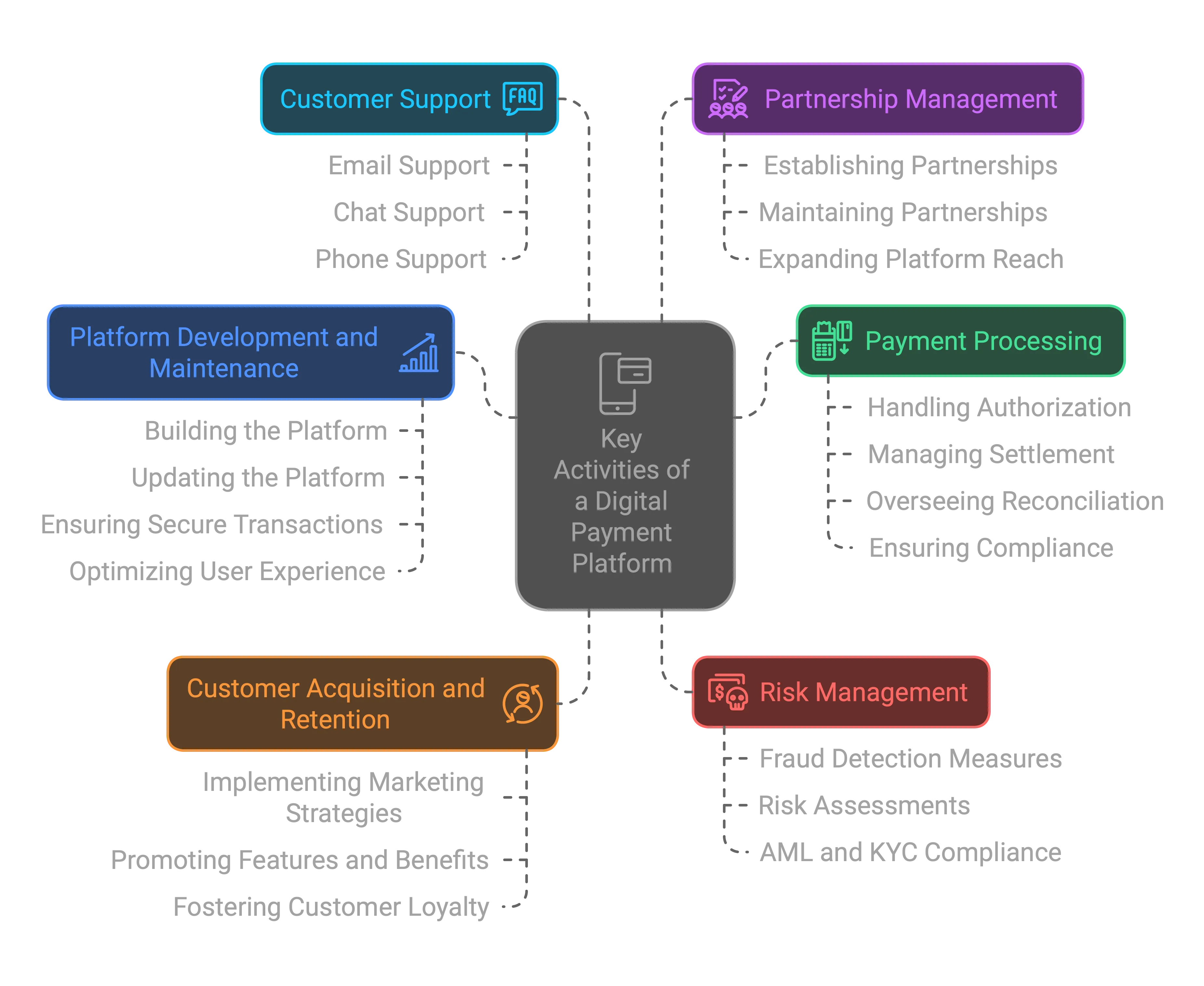
By focusing on these key activities, PayGo can deliver its value propositions effectively, build a strong customer base, and generate sustainable revenue streams.
Yet, we don’t have to do it alone; our success can be amplified through strategic Key Partnerships, where collaboration unlocks new avenues for growth.
8. Key Partnerships
Identifying and leveraging key partnerships is essential for strengthening any business model. Collaborating with the right allies can provide valuable resources, broaden your market reach, and enhance your overall value proposition. By fostering these strategic relationships, you can tap into new opportunities for innovation and growth, ensuring that your business remains resilient and competitive. Let’s explore how PayGo can cultivate partnerships that drive mutual success!
Strategic alliances and collaborations can help PayGo acquire resources, reduce risks, and optimize its business model. Key partnerships for PayGo can take various forms, such as:
- Banking and Financial Institutions : Partnering with banks and financial institutions to facilitate secure and efficient payment processing, and to expand PayGo’s reach and accessibility.
- Merchants and E-commerce Platforms : Collaborating with merchants and e-commerce platforms to integrate PayGo’s payment solutions, increase adoption, and improve the overall user experience.
- Technology Providers : Partnering with technology providers to enhance PayGo’s platform, improve security, and expand its functionality.
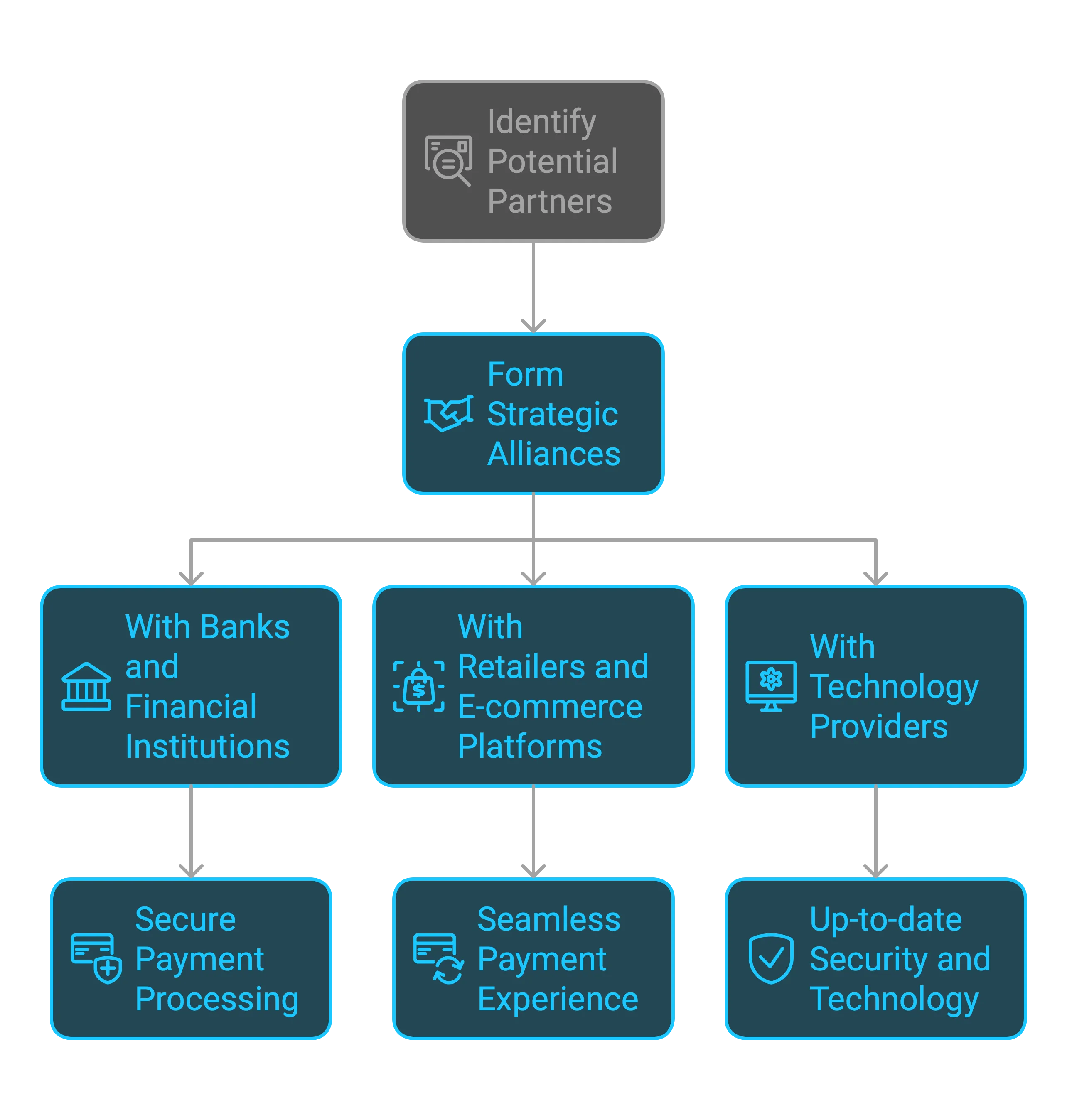
By identifying and nurturing key partnerships, PayGo can acquire the necessary resources, reduce risks, and optimize its business model to achieve long-term success.
As we weave these elements together, understanding our Cost Structure becomes crucial, ensuring we navigate expenses wisely and maintain a healthy bottom line.
9. Cost Structure
The cost structure is a vital component of the Business Model Canvas, as it details the various expenses involved in running a business. Analyzing and optimizing this cost structure is essential for maximizing profitability and ensuring long-term sustainability. By understanding your costs—whether fixed or variable—you can make informed decisions that enhance efficiency and drive growth.
Let’s dive into strategies for refining cost structure for PayGo, paving them a way for a more profitable future. In the case of PayGo, the cost structure typically consists of the following components:
- Technology and Infrastructure Costs : This includes expenses related to the development, maintenance, and hosting of PayGo’s software and hardware infrastructure. It may involve costs for servers, data centers, cloud computing services, and ongoing software updates and enhancements.
- Payment Processing Fees : PayGo often incurs fees for processing transactions, which can be a significant portion of its costs. These fees are typically charged by payment gateways, credit card networks, and other financial institutions involved in the payment process.
- Customer Support and Operations : Providing customer support, handling inquiries, and managing day-to-day operations can be labor-intensive and costly. This may include salaries for customer service representatives, technical support staff, and administrative personnel.
- Marketing and Acquisition Costs : Attracting and retaining customers is crucial for PayGo. Marketing efforts, such as advertising, promotions, and partnerships, can be expensive but necessary to build brand awareness and drive user acquisition.
- Regulatory Compliance and Security : PayGo must comply with various regulations and security standards to ensure the protection of sensitive financial data and prevent fraud. This may involve costs for security audits, certifications, and implementing robust security measures.
- Personnel and Training : PayGo requires a skilled workforce to develop, maintain, and support its products and services. This includes costs for employee salaries, training, and development programs.
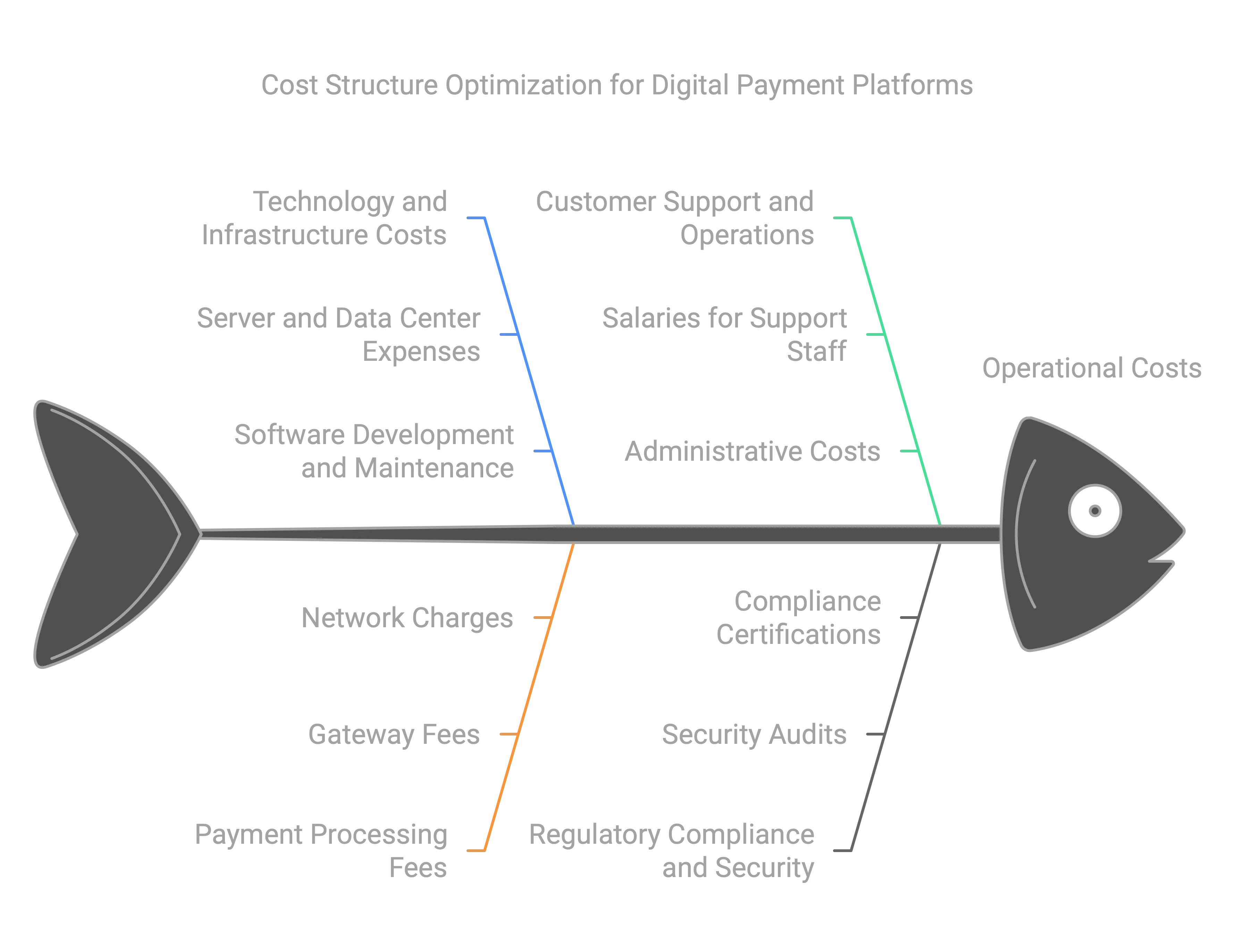
To optimize the cost structure, PayGo can leverage economies of scale, automate processes, and explore cost-effective technology solutions. Additionally, PayGo can implement pricing strategies that align with its target market and value proposition, ensuring a sustainable revenue stream while maintaining competitive pricing.
This completes the final section of the business model canvas, concluding our in-depth exploration of its components. Let’s take a moment to reflect on how these elements cohesively come together on a visual canvas.

Now that we’ve explored the various components of the business model canvas, it’s important to turn our attention to the challenges that may arise in the implementation of this model. Let’s dive into the potential hurdles we need to navigate for successful execution.
Challenges
It’s essential to recognise that while this tool provides valuable insights, it also has limitations. By confronting these challenges directly, we can implement the canvas more effectively and better align our strategies with the dynamic realities of our business landscape.
- Oversimplification: Although simplification is one of the canvas’s strengths, there is a risk of oversimplifying complex elements of your business. This could lead to overlooking critical nuances that deserve careful consideration.
- Static Nature: The canvas reflects a snapshot of your business at a given moment, which may not fully capture the dynamic essence of your evolving business model.
- Subjectivity: Varying interpretations and applications of the canvas can create diverse perspectives among team members, potentially leading to misalignment in understanding and strategy.
- Limited Quantitative Analysis: While the canvas highlights qualitative elements effectively, it may fall short in delivering robust quantitative analysis or financial projections, which are often crucial for informed decision-making.
- Implementation Challenges: Transitioning from a conceptual framework to a practical implementation plan can be a significant hurdle. Successfully converting ideas from the canvas into actionable steps requires thorough planning and execution.
Now that we’ve addressed the challenges inherent in implementing the business model canvas let’s explore the benefits it offers. Recognising these key advantages will help us appreciate the value of this strategic framework and its potential impact on our success.
Benefits
- Simplicity and Visual Representation: The canvas provides a clear and structured visual method to represent and understand your business model. This simplicity not only makes it easier to communicate ideas but also facilitates sharing them with others effectively.
- Holistic View: By encompassing all critical aspects of your organization, the canvas promotes a comprehensive perspective. This approach helps identify potential gaps, inconsistencies, and exciting opportunities for improvement.
- Facilitates Ideation and Innovation: Utilize the canvas as a launching pad for creativity and innovation. It enables teams to explore various scenarios, test assumptions, and develop fresh approaches to business modeling.
- Alignment and Collaboration: The canvas promotes alignment and collaboration among team members. With a shared language and framework, discussions about your business model become more cohesive and productive.
- Adaptability: One of the canvas’s standout features is its adaptability. Whether you’re crafting new business strategies, analyzing existing models, or considering potential pivots, the canvas serves as a versatile tool that meets diverse needs.
As you navigate the use of the Business Model Canvas, keep these benefits and challenges in mind. Striking a balance between the canvas’s visual appeal and simplicity, while ensuring depth and nuance in understanding and executing a successful business model, is key to your success. Embrace this tool, and leverage its strengths while being mindful of its limitations!
Conclusion
The Business Model Canvas stands out as an incredibly effective tool for visualizing and designing your business model. This comprehensive framework empowers you to analyze and understand the crucial components that contribute to a successful venture. By systematically examining each building block, you can uncover valuable insights into your value proposition, identify your target customers, explore revenue streams, understand your cost structure, and refine your operational processes.
In our exploration, we’ve taken PayGo as a prime example to showcase the practical application of the Business Model Canvas. Through this case study, we’ve delved into PayGo’s business model, pinpointing key elements like customer segments, value propositions, channels, and revenue streams. Additionally, we’ve investigated how PayGo harnesses the Business Model Canvas to drive innovation, tackle challenges, and seize opportunities within the market.
As you contemplate implementing the Business Model Canvas, consider how organizations like PayGo have unlocked a deeper understanding of their business model and its essential components. Are there areas where you can identify room for improvement or innovation? What unique value propositions can you create to resonate with your audience? By applying this framework, you can develop effective channels and revenue streams, laying the groundwork for a robust and sustainable business model that drives growth and success.
Ultimately, the Business Model Canvas serves as your blueprint for creating, delivering, and capturing value, empowering you to navigate the complexities of today’s marketplace and adapt to ever-changing market dynamics. Embrace this tool, and watch your entrepreneurial journey flourish!